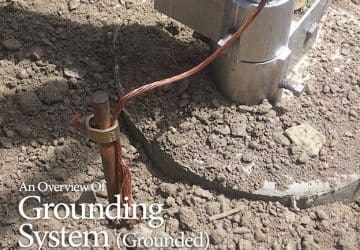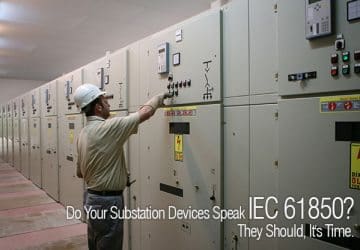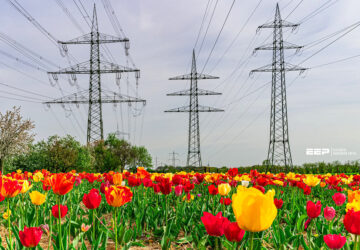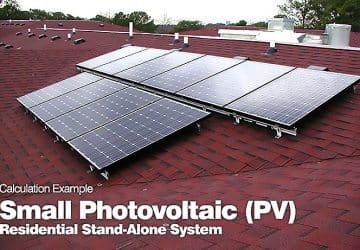An Overview Of Grounding System (Grounded)
Continued from technical article: An Overview Of Grounding System (Ungrounded) Solidly grounded system Resistance grounded system Reason for resistance grounding System earthing at EHV level Let us assume that R phase (Phase-3 in figure-3) is shorted to ground than: If… Read more
Oct 14, 2013 | By Asif Eqbal

An Overview Of Grounding System (Ungrounded)
Ungrounded system Derivation of current expression in ungrounded system Advantages & disadvantages of ungrounded system Concept of effective and non-effective grounding Coefficient of earthing and earth fault factor Before 1950 power system were often without neutral grounding. Such system had… Read more
Oct 11, 2013 | By Asif Eqbal

What’s Really Important When You’re Designing The Low Voltage Switchgear?
Here what’s important when you’re designing the low voltage switchgear: Device Application in the Supply Circuit Short-circuit strength Release (Trip Unit) Device Application in Supply Circuits (Coupling) Device Application in the Distribution Circuit Device Application in the Final Circuit The… Read more
Oct 07, 2013 | By Edvard Csanyi

Why Community Acceptance Is Important for Planning, Design and Construction of Substation?
Community acceptance generally encompasses the planning, design, and construction phases of a substation as well as the in-service operation of the substation. It takes into account those issues that could influence a community’s willingness to accept building a substation at… Read more
Sep 30, 2013 | By Edvard Csanyi

Do Your Substation Devices Speak IEC 61850? They Should, It’s Time.
Since being published in 2004, the IEC 61850 communication standard has gained more and more relevance in the field of substation automation. It provides an effective response to the needs of the open, deregulated energy market, which requires both reliable… Read more
Sep 27, 2013 | By Edvard Csanyi

Determining the soil resistivity to design a good substation grounding system
It is essential to determine the soil resistivity and maximum grid currents to design a substation grounding system. The touch and step voltages are directly proportional to these values. Overly conservative values of soil resistivity and grid current will increase… Read more
Sep 04, 2013 | By Edvard Csanyi

Total Losses in Power Distribution and Transmission Lines
This technical article discusses two types of transmission and distribution losses, technical losses and non-technical losses (or commercial losses). Power generated in power stations pass through large and complex networks like transformers, overhead lines, cables and other equipment and reaches… Read more
Aug 19, 2013 | By Jignesh Parmar

Where do the strongest electric and magnetic fields come from in a power substation?
Electric substations produce electric and magnetic fields. In a substation, the strongest fields around the perimeter fence come from the transmission and distribution lines entering and leaving the substation. The strength of fields from equipment inside the fence decreases rapidly… Read more
Aug 05, 2013 | By Edvard Csanyi

Calculation Example of Small Photovoltaic (PV) Residential Stand-Alone System
– Array Size: 10, 12-volt, 51-watt modules; Isc= 3.25 amps, Voc= 20.7 volts – Batteries: 800 amp-hours at 12 volts – Loads: 5 amps DC and 500-watt inverterwith 90% efficiency. The PV modules are mounted on the roof. Single-conductor cables… Read more
Jul 12, 2013 | By Edvard Csanyi

Requirements and Functions of Substation Automation
Substation automation is the cutting edge technology in electrical engineering. It means having an intelligent, interactive power distribution network including : Increased performance and reliability of electrical protection. Advanced disturbance and event recording capabilities, aiding in detailed electrical fault analysis…. Read more
May 17, 2013 | By Edvard Csanyi

How to Determine Correct Number of Earthing Electrodes (Strips, Plates and Pipes) – part 2
Continued from first part: How to Determine Correct Number of Earthing Electrodes (Strips, Plates and Pipes) – part 1 The Earth Resistance of Single Plate electrode is calculated as per IS 3040: R=ρ/A√(3.14/A) Where: ρ = Resistivity of Soil (Ω… Read more
May 13, 2013 | By Jignesh Parmar

Responding to Cyber Intrusion in SCADA System
Continued from technical article: Detecting Cyber Intrusion in SCADA System The “three R’s” of the response to cyber intrusion are: Recording, Reporting, and Restoring. Theoretically, it would be desirable to record all data communications into and out of all substation… Read more
Apr 08, 2013 | By Edvard Csanyi

Detecting Cyber Intrusion in SCADA System
One of the axioms of cyber security is that although it is extremely important to try to prevent intrusions into one’s systems and databases, it is essential that intrusions be detected if they do occur. One of the axioms of… Read more
Apr 06, 2013 | By Edvard Csanyi

How to Determine Correct Number of Earthing Electrodes (Strips, Plates and Pipes) – part 1
Earthing Resistance and the number of earthing electrodes are both dependent on the resistivity of the soil as well as the amount of time it takes for fault current to pass through (one second or three seconds). The number of… Read more
Apr 05, 2013 | By Jignesh Parmar

Active fire protection measures in power substation
Active fire protection measures are automatic fire protection measures that warn occupants of the existence of fire, and extinguish or control the fire. These measures are designed to automatically extinguish or control a fire at its earliest stage, without risking… Read more
Apr 01, 2013 | By Edvard Csanyi


